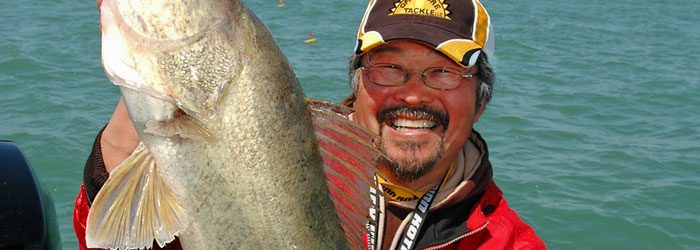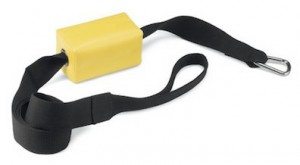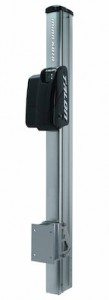Boat Control

Hall of Fame fisherman Ted Takasaki uses a remote control to steer his boat with a bow-mounted electric trolling motor. Follow the tips Takasaki offers for using all boat-control tools and you can turn the wind from an enemy into a friend.
I’ve probably asked a thousand anglers what they struggle with most. Almost all of them have asked me back “how do I control my boat in the wind?” Boat control is one of the most critical concepts for any angler to master.
A stiff breeze can be tough, but active fish often concentrate on the windy side of a lake or reservoir where the food chain goes wild and walleyes can use their keen sight and lateral lines to their advantage. The wind breaks up light penetration as well.
We’ve all seen it. Wind blows, hammer fish, wind stops, and so does the bite. The key is to learn boat control techniques that make the wind your friend.
A strong wind makes controlling boat speed difficult. Walleyes can be selective and finicky. Like all predators, they’d rather their food come to them, as they instinctively reserve energy for growing and reproducing. They tend to avoid chasing lures or bait. As a result, more walleyes are typically caught when the boat is moving slower than 1.5 mph.
Sometimes, wind moves a boat faster than you want it to go. It’s a good thing there are tools you can use to slow down!
1. Trolling Motors
In a slight breeze, turn the bow of the boat into the wind in order to work the contours of structures. When buying a boat, equip it with the most-powerful trolling motor and the longest shaft you can afford. MinnKota’s Terrova trolling motor is a great aid for most walleye anglers. The I-pilot feature allows you to set the direction in which you want to move the boat. It also has a feature called Spot Lock, which turns your trolling motor into an anchor that keeps the boat in one spot. The I-pilot Link feature follows LakeMaster contours without having to do anything at all.
Backtrolling with a gas tiller motor can offer even more control in stronger breezes. Be subtle. Make minor adjustments in speed, not major ones.
* For console boats, a gas-powered ‘kicker’ motor gives you additional power in order to neutralize the wind speed. A bow-mounted electric trolling motor can then be used with the gas kicker to steer side-to-side and keep your boat in position in a strong wind.
We also like to use the Terrova in conjunction with the gas kicker when trolling. This is called a push/pull technique and is invaluable when trying to stay at a specific depth. The boat is always more responsive when it’s controlled by the front, but pushed from behind.
2. Drift socks
Never leave the dock without one or two in the boat. They can slow the boat by as much as 40%, even in a stiff breeze. Get the right size drift sock for your boat. Too small is no good. Two different sizes can come in handy. Drift socks are used most when drifting flats and to insure a drift perpendicular to the wind, a larger drift sock should be attached towards the bow which can often catch the wind and push the bow down wind.
To drift a contour precisely, put out the drift socks, turn the bow towards the direction of the wind and use your trolling motor to stay on the edge. In other words, if the wind is angled towards the shore, keep the bow of the boat away from the shore and make subtle adjustments to stay on the break.
While casting baits to a shoreline, a drift sock tied towards the rear of the boat while drifting also slows the boat to allow more casts to productive spots.
If you like to troll forward and the boat is moving too fast, tie two identical drift socks off the forward cleats so they are open at mid-ship. This tactic can cut boat speed 30 to 50% and make the boat easier to control.
3. A Harness Buoy
This is a great accessory. Just release the harness buoy from the boat to get the drift sock out of the way when you are fighting a big fish. Return for the drift sock when the fish is safely in your net.
Another advantage to this is the buoy has marked the place where the fish took your bait. Where there’s one, there could be more.
4. Anchoring your boat
Anchoring in one spot is the ultimate form of boat control.
Drop one when you find the spot where you have a high degree of confidence that walleyes are there or will show up soon.
For example try anchoring over that rock pile on a point or where coontail meets cabbage. The change in weed type often signals a fish-attracting change in the bottom content.
While anchored you can still move the boat to new areas of the structure and fish them thoroughly by simply moving the rope from one cleat to another or to the bow. You can cover a lot of territory without pulling the anchor.
Use a heavy Navy style anchor. Have plenty of rope….as much as 100 to 150 feet. Too little rope and the anchor won’t hold. If you anchor a lot, it’s best to have 2 anchors onboard.
Even sitting still the wind can give your bait motion. Cast slip bobbers into the wind and let the breeze blow them back past the boat to cover a larger area.
5. Talon
Another new tool in the arsenal is called the Talon. This is a mechanical shallow water anchor that’s placed on the transom of the boat. You have a control that moves a rod up and down and the rod sticks into the lake bottom, preventing the boat from moving. It’s much easier to deploy than an actual anchor.
6. GPS is also a great tool
Speed measurements are far more precise using satellite technology. Check how fast the boat is moving as soon as you catch a fish so you can replicate the speed.
You can vary the speed and direction of your baits in other ways, too. When searching for suspended fish, troll with the wind and make S-turns to vary the speed. Outside lures travel faster, inside lures go slower. Stall your baits once in a while, too. Sometimes that’s all you need to do in order to trigger a bite.
Vary your retrieve speed and direction when casting jigs or crankbaits. Rip a crankbait and let it stop. Pop a jig, pop, pop, pop, then let it fall, and drag it. Move bottom-bouncers up the edges of structure and down while reaching back to tap the bottom to entice more bites.
Use the wind to your advantage and these tools to control it. You’ll soon find that the wind can be your friend and help you catch more fish.
About Ted Takasaki
Hall of Fame Legendary Angler Ted Takasaki, is a top competitor on the FLW Walleye Tour. Ted dominated many PWT events including the prestigious PWT Classic Championship in 1998 and the 1995 PWT Top Gun Angler Award. In 2002, Ted smashed the all time, one day PWT tournament record with 5 walleyes at 53.2 pounds! Ted was also a part of the team that won the coveted 1993 Mercury National Tournament held on Lake Winnebago, Wisconsin. Ted is found in many national outdoor magazines, led hundreds of walleye seminars across the Midwest and hosted numerous TV shows. We welcome Ted’s experience here at Bass Fishing Gurus.
Click here to find out more about Minn Kota’s Terrova motor on Amazon.
You’ll find more insight from Ted in these articles.






